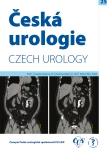The place of laparoscopy in the surgical treatment of urolithiasis
Authors:
Michaela Motolová
Authors‘ workplace:
Urologie, Barmherzige Schwestern Krankenhaus Wien
Published in:
Ces Urol 2021; 25(3): 204-212
Category:
Original Articles
Overview
Objective: The aim of this case study is to show the advantages of laparoscopic management for therapy of complex and large pelvi-/uretherolithiasis, particularly in situations where an endoscopic approach is not successful or feasible. Simultaneously it should encourage the experienced laparoscopic surgeons to broaden their fields of interest to the therapy of urolithiasis.
Methods: This single-center, retrospective study presents data collected from 02/2017 to 02/2021. Inclusion criteria: Primary laparoscopic access for therapy of lithiasis in upper urinary tract in a single session. Altogether 16 patients were subsumed – with these indications: 2× pyelolitomy (PL) for calculi in one-half of a horseshoe kidney, 5× PL for solitary large renal pelvic stones, 2× ureterolithotomy (UL) for management of large proximal ureteric stones 1× UL in the indication of an encrusted ureteral stent, with maximum stone – mass in distal ureteral portion. 6× pyeloplasty with concomitant pyelolithotomy. Primary endpoint was the evaluation of effectivity of the laparoscopic procedures based on stone free rate, operative time, complication-rate and recovery time. Secondary endpoint was the comparision with endoscopy – retrograde intrarenal surgery and percutaneus nephrolithotomy.
Results: Stone free results were achieved in all cases of our study – 100% in only 1 session. Average OP time was 42 minutes. The maximal grade of complications according to the Clavien–Dindo classification was Grade I. Age range of patients: from 24 to 78 years. Average hospitalization time was 4 days. No additional radiation exposure of patients was necessary.
Conclusion: Laparoscopic stone surgery is reserved for extraordinary situations, in rare cases of selected patients. In expert hands it is a safe and minimally invasive modality with high efficacy, therefore is of growing interest to urologists all over the world.
Keywords:
laparoscopy – pyelolithotomy +/- pyeloplasty – ren arcuatus – ureterolithotomy
Sources
1. Kijvikai K. The role of laparoscopic surgery for renal calculi management. Ther Adv Urol 2011; 3(1): 13–18. doi: 10.1177/1756287211398254.
2. Lusuardi L, Janetschek G. Indications and outcomes of laparoscopic uretero-renal stone surgery. Curr Opin Urol 2011; 21(2): 161–165. doi: 10.1097/MOU.0b013e3283430afc
3. Bai Y, Tang Y, Deng L, et al. Management of large renal stones: laparoscopic pyelolithotomy versus percutaneous nephrolithotomy. BMC Urol 2017; 17(1): 75. Published 2017 Aug 31. doi: 10.1186/s12894-017-0266-7.
4. Jiang JT, Li WG, Zhu YP, et al. Comparison of the clinical efficacy and safety of retroperitoneal laparoscopic ureterolithotomy and ureteroscopic holmium laser lithotripsy in the treatment of obstructive upper ureteral calculi with concurrent urinary tract infections. Lasers Med Sci 2016; 31(5): 915–920. doi: 10.1007/ s10103-016-1932-9.
5. Aminsharifi A, Irani D, Masoumi M, et al. The management of large staghorn renal stones by percutaneous versus laparoscopic versus open nephrolithotomy: a comparative analysis of clinical efficacy and functional outcome. Urolithiasis 2016; 44(6): 551–557. doi: 10.1007/s00240-016-0877-6.
6. Kadihasanoglu M, Yucetas U, Karabay E, Sonmezay E. Comparison of the outcomes of laparoscopic pyeloplasty with and without concomitant pyelolithotomy. Int Braz J Urol 2019; 45(5): 965–973. doi: 10.1590/ S1677-5538.IBJU.2018.0781.
7. Lavan L, Herrmann T, Netsch Ch, et al. Outcomes of ureteroscopy for stone disease in anomalous kidney: a systematic review. World Journal of Urology 2020; 38: 1135–1146. doi: 10.1007/s00345-019-02810-x.
8. Madi R, Hemal A. Robotic Pyelolithotomy, Extended Pyelolithotomy, Nephrolithotomy and Anatrophic Nephrolithotomy. J Endourol 2018; 32(S1): S73–S81. doi: 10.1089/end.2017.0718.
9. Sachin P, Ashish Y, Nitin P, Devendra KJ. Laparoscopy assisted percutaneous nephrolithotomy in patients with ectopic pelvic kidneys: experience in 24 patients. International Journal of Anatomy, Radiology and Surgery 2021; 10(1): SO17–SO20. doi: 10.7680/IJARS/2021/46515:2606.
Labels
Paediatric urologist Nephrology UrologyArticle was published in
Czech Urology

2021 Issue 3
Most read in this issue
- Peroperative histology during robotic-assisted radical prostatectomy with lymphadenectomy: a feasibility study
- Postnatal activation of the hypothalamo-pituitary-gonadal axis (minipuberty) and undescended testicle
- Warning time and his role in the conservative treatment of overactive bladder
- Our technigue of robot-assisted radical cystectomy in women
